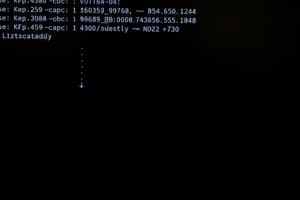Podcast
Questions and Answers
What does CLI stand for in networking?
What does CLI stand for in networking?
- Command Line Interface (correct)
- Control Line Interface
- Configuration Line Interface
- Central Line Interface
Which of the following is NOT a common routing protocol?
Which of the following is NOT a common routing protocol?
- TCP (correct)
- BGP
- RIP
- EIGRP
What is the main purpose of interface configuration on networking devices?
What is the main purpose of interface configuration on networking devices?
- Managing routing protocols
- Configuring QoS settings
- Establishing wireless connections
- Setting up individual interfaces (correct)
Which aspect of network management involves setting up security features to ensure smooth communication?
Which aspect of network management involves setting up security features to ensure smooth communication?
Which protocol is commonly used to manage routing in large networks and the internet?
Which protocol is commonly used to manage routing in large networks and the internet?
What type of configurations can be performed through the CLI on routers and switches?
What type of configurations can be performed through the CLI on routers and switches?
What is involved in wireless configuration?
What is involved in wireless configuration?
What is the purpose of VLANs?
What is the purpose of VLANs?
Which task is a part of interface configuration?
Which task is a part of interface configuration?
What is the main focus of CLI configuration?
What is the main focus of CLI configuration?
Which task is NOT associated with wireless configuration?
Which task is NOT associated with wireless configuration?
What is the purpose of routing protocols configuration?
What is the purpose of routing protocols configuration?
Flashcards are hidden until you start studying
Study Notes
Device Configuration is a crucial aspect of network management, especially when working with complex networking environments. It involves setting up various components such as interfaces, routes, and security features to ensure smooth communication between devices within a network. Here, we will explore several key subtopics in device configuration:
CLI Configuration
CLI stands for Command Line Interface, which is often used for configuring routers and switches. This is typically done through a console port or via Telnet using a remote terminal application. The commands issued by the user are interpreted by the router's operating system and executed accordingly. These commands can range from simple changes like setting IP addresses to more advanced configurations involving QoS settings, ACLs, and other important features.
Routing Protocols Configuration
Router configuration involves managing routing protocols, which control how data packets are forwarded across networks. Some common routing protocols include RIP, OSPF, BGP, EIGRP, and IS-IS. Each has its own set of rules and procedures for exchanging information about the network topology. Proper configuration of these protocols ensures efficient packet forwarding among different parts of the network.
Interface Configuration
Interface configuration refers to the setup of individual interfaces on networking devices. This includes tasks such as assigning IP addresses, enabling and disabling services, and configuring MTU sizes. All these steps are necessary for interfaces to function correctly and communicate effectively.
Wireless Configuration
With the ubiquity of Wi-Fi technology, wireless configuration is becoming increasingly important. This involves setting up access points, securing them with encryption protocols, and configuring additional features such as QoS or bandwidth management. Wireless configuration is a critical aspect of modern networking as it enables wireless communication between devices.
VLAN Configuration
VLANs (Virtual Local Area Networks) are used to create multiple virtual networks on a single physical network. They help isolate different types of traffic and provide better security and control over network traffic. Configuring VLANs involves creating VLANs, assigning ports to VLANs, and managing the VLAN database.
In summary, device configuration is a broad topic encompassing various aspects of network management. Understanding the basics of CLI, routing protocols, interface configuration, wireless configuration, and VLAN configuration is essential for any network administrator or engineer. These configurations are the backbone of any robust and efficient network infrastructure.
Studying That Suits You
Use AI to generate personalized quizzes and flashcards to suit your learning preferences.




